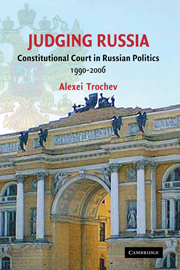Book contents
- Frontmatter
- Contents
- List of Figures and Tables
- Acknowledgments
- Abbreviations
- Notes on Transliteration
- 1 Introduction: Three Puzzles of Postcommunist Judicial Empowerment
- 2 Nonlinear Judicial Empowerment
- 3 Making and Remaking Constitutional Review, Russian-Style
- 4 Russian Constitutional Review in Action (1990–1993)
- 5 Decision Making of the 2nd Russian Constitutional Court: 1995–2006
- 6 The Constitutional Court Has Ruled – What Next?
- 7 The 2nd Russian Constitutional Court (1995–2007): Problematique of Implementation
- 8 “Tinkering with Judicial Tenure” and “Wars of Courts” in Comparative Perspective
- 9 Conclusion: Zigzagging Judicial Power
- Appendix
- Bibliography
- Statutes and Decrees
- Court Decisions
- Index
6 - The Constitutional Court Has Ruled – What Next?
Published online by Cambridge University Press: 25 July 2009
- Frontmatter
- Contents
- List of Figures and Tables
- Acknowledgments
- Abbreviations
- Notes on Transliteration
- 1 Introduction: Three Puzzles of Postcommunist Judicial Empowerment
- 2 Nonlinear Judicial Empowerment
- 3 Making and Remaking Constitutional Review, Russian-Style
- 4 Russian Constitutional Review in Action (1990–1993)
- 5 Decision Making of the 2nd Russian Constitutional Court: 1995–2006
- 6 The Constitutional Court Has Ruled – What Next?
- 7 The 2nd Russian Constitutional Court (1995–2007): Problematique of Implementation
- 8 “Tinkering with Judicial Tenure” and “Wars of Courts” in Comparative Perspective
- 9 Conclusion: Zigzagging Judicial Power
- Appendix
- Bibliography
- Statutes and Decrees
- Court Decisions
- Index
Summary
Twice, in 1993, the Constitutional Court of the Russian Federation, with its hasty decisions and actions, pushed the country to the brink of the civil war.
– Russian President Boris YeltsinChapters 3–5 explained how and why Russia's politicians designed and redesigned the federal constitutional court, and how and why this court functioned the way it did in its first decade and a half. To be sure, the business of creating high courts and conducting judicial review is never done in a vacuum, devoid of a sociopolitical context. This context involves the extent of compliance with the decisions of the constitutional courts, a third element of the trilateral dynamic of judicial review power, as I argued in Chapter 2. Compliance consists of both judicial foresight (How will the elites and the public react to the court decision?) and the actual reaction of the powers-that-be and society, in general, to the judicial decisions: attacks on the very institution of constitutional review, disobedience and delay, or quiet acquiescence. What accounts for this variation? Without studying the actual patterns of compliance and defiance with the decisions of the constitutional courts, one cannot tell how these courts make a difference outside the courthouse: does judicial review bring about significant social change or do courts produce just another “hollow hope”?
As I discussed in Chapter 2, scholars have not reached a consensus on the best strategy for a young constitutional court to improve compliance.
- Type
- Chapter
- Information
- Judging RussiaThe Role of the Constitutional Court in Russian Politics 1990–2006, pp. 188 - 206Publisher: Cambridge University PressPrint publication year: 2008



